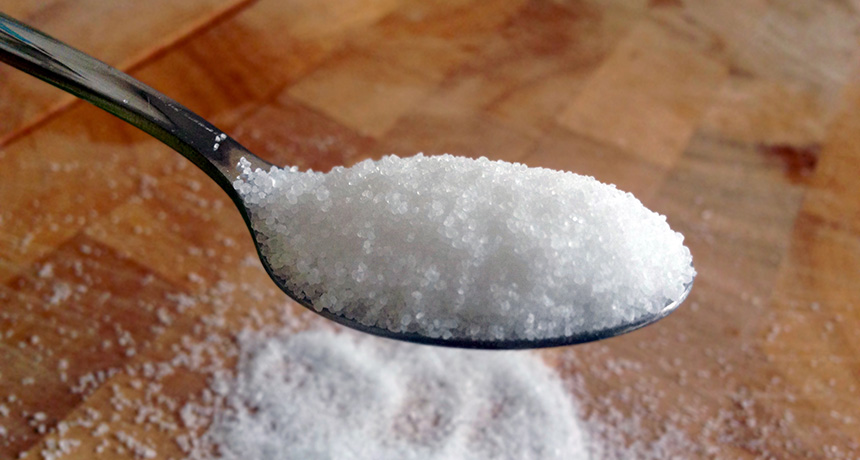Sugar industry sought to sugarcoat causes of heart disease
Payments revealed to authors of influential 1967 report touting fat and cholesterol as problems

NOT SO SWEET An influential scientific review published in the 1960s, which downplayed the role of sugar in heart disease, was written by researchers who were paid by the sugar industry.
Health Gauge/flickr (CC BY 2.0)
Using records unearthed from library storage vaults, researchers recently revealed that the sugar industry paid nutrition experts from Harvard University to downplay studies linking sugar and heart disease. Although the incident happened in the 1960s, it appears to have helped redirect the scientific narrative for decades.
The documents — which include correspondence, symposium programs and annual reports — show that the Sugar Research Foundation (as it was named at the time) paid professors who wrote a two-part review in 1967 in the New England Journal of Medicine. That report was highly skeptical of the evidence linking sugar to cardiovascular problems but accepting of the role of fat. The now-deceased professors’ overall conclusion left “no doubt” that reducing the risk of heart disease was a matter of reducing saturated fat and cholesterol, according to researchers from the University of California, San Francisco, who published their report online September 12 in JAMA Internal Medicine.
“Why does it matter today? The sugar industry helped deflect the way the research was developing,” says study coauthor Cristin Kearns, a dentist at UCSF’s Institute for Health Policy Studies. The Harvard team’s scientific favoritism had a role in directing research and policy attention toward fat and cholesterol. And in fact, the first dietary guidelines published by the federal government in 1980 said there was no convincing evidence that sugar causes heart disease, stating “the major health hazard from too much sugar is tooth decay.”
Following the publication of the Harvard report, fat and cholesterol went on to hijack the scientific agenda for decades, and even led to a craze of low-fat foods that often added sugar. Kearns points out that it was only in 2015 that dietary guidelines finally made a strong statement to limit sugar. Researchers writing this year in Progress in Cardiovascular Diseases note that current studies estimate that diets high in added sugars carry a three times higher risk of death from cardiovascular disease. (For its part, the Sugar Association says in a statement on its website that “the last several decades of research have concluded that sugar does not have a unique role in heart disease.”)
The level at which the food industry continues to influence nutrition research is still a much-debated topic. The Sugar Association’s statement acknowledged the secret deal occurred, but pointed out that “when the studies in question were published, funding disclosures and transparency standards were not the norm they are today.” Journals now require all authors to list conflicts of interest, especially funding from a source has a vested interest in the outcome.
That doesn’t mean that trade groups and industry associations no longer have an influence on scientists, says Andy Bellatti, cofounder and strategic director of Dietitians for Professional Integrity, which has campaigned to push the Academy of Nutrition and Dietetics to sever its ties with industry, While a modern researcher could not take corporate money, even for speaking fees, without disclosure, the influences may be more subtle, he says. “We’re not talking about making up data, but perhaps influencing how a research question is framed.”
In a commentary published with the JAMA study, Marion Nestle, a nutrition researcher at New York University, wrote that industry influence has not disappeared. She cited recent New York Times investigations of Coca-Cola–sponsored research and Associated Press stories revealing that a candy trade group sponsored research attempting to show that children who eat sweets have a healthy body weight.
Bellatti says that researchers don’t necessarily want to be cozy with industry, but sometimes turn to commercial sources because non-biased research money is lacking. “The reason the food industry is able to do this is because there is such little public funding for nutrition and disease,” Bellatti says.
For that reason, the scientific community should not reject industry money wholesale, says John Sievenpiper, a physician and nutrition researcher at the University of Toronto. A study of his was once ridiculed on Nestle’s blog because the disclosures covered two full pages. He believes that any scientist who takes industry money should adhere to an even higher standard of openness, including releasing study protocols ahead of time so reviewers can make sure the research question was not changed midstream to favor a certain conclusion.
While many parallels have been made between the food and tobacco industries, Sievenpiper believes those comparisons miss the complicated nature of the human diet. Tobacco is always bad, never good. Sugar, fat, cholesterol and other components of diet are some of both, making research into their effects much more nuanced, he says. And unlike with tobacco, the solution can’t be to never eat them. He believes solutions won’t involve turning single nutrients like fat or sugar into villains, but promoting better overall patterns of eating, like the Mediterranean diet.
Kearns, who has spent the past 10 years looking into the sugar industry’s influence on science, isn’t finished yet. She says her curiosity first arose during a conference on gum disease and diabetes in 2007, when she noticed a lack of scientific discussion of sugar. She started out simply Googling industry influences. The trail eventually led her to scour library archives, until she came across dusty boxes of records from a closed sugar company in Colorado. “The first page I looked at in that archive had a confidential memo,” she says. “I knew I had something no one else had never talked about before.”
She doesn’t see the research going sour any time soon. “This was their 226th project in 1965,” she says. “There’s a lot more to the story.”
Editor’s Note: This story was updated September 29, 2016, to clarify what the 1980 dietary guidelines said about sugar and heart disease.







